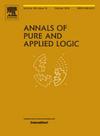Model-theoretic K1 of free modules over PIDs
IF 0.6
2区 数学
Q2 LOGIC
引用次数: 0
Abstract
Motivated by Krajiček and Scanlon's definition of the Grothendieck ring of a first-order structure M, we introduce the definition of K-groups for via Quillen's construction. We provide a recipe for the computation of , where is a free module over a PID R, subject to the knowledge of the abelianizations of the general linear groups . As a consequence, we provide explicit computations of when R belongs to a large class of Euclidean domains that includes fields with at least 3 elements and polynomial rings over fields with characteristic 0. We also show that the algebraic of a PID R embeds into .
pid上自由模的模型论K1
基于krajiekk和Scanlon关于一阶结构M的Grothendieck环K0(M)的定义,我们通过Quillen的S−1S构造引入了n≥0时k群Kn(M)的定义。我们提供了K1(MR)的计算公式,其中MR是PID R上的自由模,受一般线性群GLn(R)的阿贝尔化的知识的约束。因此,我们提供了K1(MR)的显式计算,当R属于欧几里得域的一大类,其中包括至少有3个元素的域和特征为0的域上的多项式环。我们还证明了PID R的代数K1嵌入到K1(RR)中。
本文章由计算机程序翻译,如有差异,请以英文原文为准。
求助全文
约1分钟内获得全文
求助全文
来源期刊
CiteScore
1.40
自引率
12.50%
发文量
78
审稿时长
200 days
期刊介绍:
The journal Annals of Pure and Applied Logic publishes high quality papers in all areas of mathematical logic as well as applications of logic in mathematics, in theoretical computer science and in other related disciplines. All submissions to the journal should be mathematically correct, well written (preferably in English)and contain relevant new results that are of significant interest to a substantial number of logicians. The journal also considers submissions that are somewhat too long to be published by other journals while being too short to form a separate memoir provided that they are of particular outstanding quality and broad interest. In addition, Annals of Pure and Applied Logic occasionally publishes special issues of selected papers from well-chosen conferences in pure and applied logic.

 求助内容:
求助内容: 应助结果提醒方式:
应助结果提醒方式:


